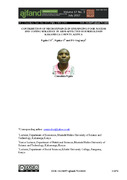| dc.description.abstract | Acquired immune deficiency syndrome (AIDS) pandemic increases a family’s food
insecurity by reducing the family’s ability to produce food, which compromises their
output and income. This reduces their food availability, accessibility and acquisition,
and interferes with regular nutritional intake. In response, households develop various
coping strategies, especially in the context of food shortages. Arguably, microfinance
(MF) has been advocated by many as an antidote to disasters affecting the households
in different disaster contexts, such as famine, poverty, and tsunami occurrences. This
study, therefore, sought to find out the contribution of MF to AIDS-affected households
in terms of food access and coping strategies in Kakamega County, Kenya.
Specifically, the study determined the effect of MF on the proportion of income spent
on food, and number of meals consumed in a day. It also sought to illuminate the
coping strategies adopted by AIDS-affected households with and without MF in the
context of food shortages. This study adopted both qualitative and quantitative
approaches with an experimental framework. A sample of 404 AIDS-affected
household heads was included in the study. Findings from descriptive and inferential
analyses revealed that over 50% of AIDS-affected households before MF were
spending their income on food irrespective of loan status, and there was a highly
statistically significant difference in the proportion of income spent on food by affected
households with and without MF. Those households with MF spent almost twice of
their income on food compared to those without MF. There was also a highly
statistically significant difference in the number of meals consumed between those
households with and without MF, in favour of those with MF. Households with MF
took relatively more meals. Lastly, households without MF adopted more severe coping
strategies when faced with food shortages. The study concluded that affected
households with MF had easy access to food, ate the required number of meals and
adopted less severe coping strategies. This was because MF services came as a package
of money, training and advisory on business and health-related issues, which did not
only improve household income but also enhanced food access and enabled adoption of
less severe coping strategies in AIDS-affected households in Kakamega County. | en_US |

